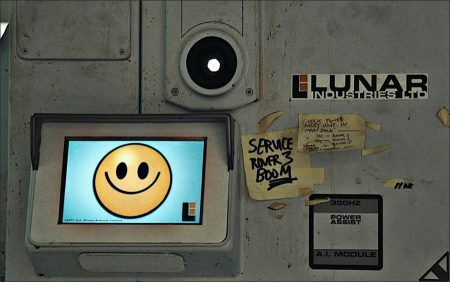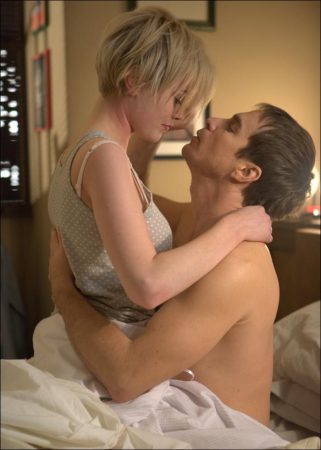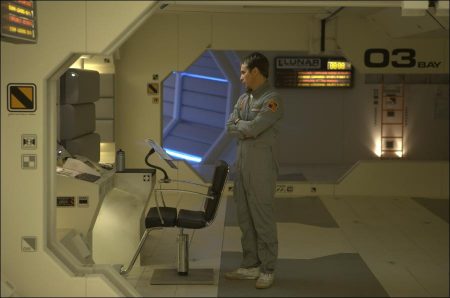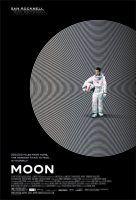All About Moon: Perfect SF Question
“Moon was a challenge to write,” continues Jones. “There was a set of pretty stringent criteria that my producer, Stuart Fenegan, and I had come up with for ourselves, to give us the best chance of getting the film made. I had to keep in mind a very limited budget, $5M; keep the cast as small as possible; and write something that would best be done in a controlled studio environment, all while utilizing a very specific set of visual effects that would maximize production value for minimum cost. “I was writing it specifically for Sam Rockwell, so it had to have something fundamentally challenging or at least exciting for him to get his teeth into as an actor, but the film as a whole also needed to have mainstream appeal.
“It occurred to me that I could address many of the criteria we had set ourselves if Sam were to play multiple roles. Sam would get a challenge as an actor, I could keep my cast small and as a team we could focus most of our efforts on achieving a very specific type of visual effect. Cloning seemed to fit well into the embryonic story I was playing with of a man stuck in a moon base. I got excited thinking: “If you met you in person, would you like yourself?” I think it’s the most brutal, honest and human question there is…and that makes it perfect for sci-fi.”
The dual-role challenge won over Rockwell. “It is not far fetched to say that the technical responsibilities put on Sam’s shoulders were some of the most demanding an actor has been asked to deal with in recent years,” says Jones. “Other films in the past have had an actor perform with himself, but never to the degree that Sam did in MOON. His phenomenal skill and near infinite patience made MOON not only possible, but pushed back the boundaries on this very tricky and unforgiving effect. When you do it wrong, it’s very obvious-and when you do it right, it’s invisible. Films like Cronenberg’s Dead Ringers and Spike Jonze’s Adaptation previously wore the crown, and were inspirations to us. Now I hope people will look to MOON to see how it’s done.”
Rockwell’s performance won Kevin Spacey’s participation, as well. “When we showed Kevin the rough cut,” says Jones, “Even with its temp sound and placeholder visual effects, he was just knocked out by how good Sam’s performance was. He signed on then and there.”
Through the Airlock
Figuring out how to film two Rockwells in one was hardly the only production hurdle. “The film was technically and logistically very difficult,” admits Jones. “We filmed over 33 intense, highly technical days of shooting at Shepperton studios, in the same sound stage where Ridley Scott shot Alien nearly 30 years before. The set of Sarang was a 360-degree environment. The crew would go in through the airlock in the morning, and be sealed inside the base for the rest of the day.
Jones, production designer Tony Noble, and concept artist Gavin Rothery had talked exhaustively about how to capture the look and feel of beloved sci-fi films while taking advantage of their own up-to-date effects expertise. “I had a background in effects-heavy commercials in Britain,” says Jones, “In particular those jobs that blended computer generated effects with live action photography. It gave me a confidence and awareness of which effects would be most cost effective, where we could get the biggest bang for our buck. We knew that by using some old school techniques like model miniatures, a retro (and cost effective) production design, and then by building a layer of contemporary CG effects on top, we could create a hybrid live action/CG style. It would create a sumptuous and textured look; beyond what you get with pure CG. But it’s something you don’t see much of in feature films.”
As befits a story line about a nuts-and-bolts mining operation, “We wanted the base and its vehicles to have the same “grit and big boots” feel as the old sci-fi we missed, as opposed to the more contemporary (but wimpier) iPod-style glass and touch-screen design most sci-fi seems to go for these days. Things would look like they were made of concrete. The architecture would look engineered and have hard angles. Tony Noble pulled off miracles to make our visualizations a reality.”
Beyond the cold white interior of the station lay the moon’s surface. “As a bible for the look of the lunar exteriors, we relied on Full Moon by Michael Light, an amazing collection of NASA photos from the Apollo missions, filled with beautiful, high-contrast 70mm photography of the moon from both space and its surface. It gave me a very clear idea of what I wanted the exteriors of our film to look like. We worked with Bill Pearson, model genius of Alien fame, to create live-action models and sections of lunar landscape for our vehicles to run across, and then with the help of the fantastic London special-effects house Cinesite, we enhanced the models and digitally extended the landscapes.”
Jones loves the idea of fellow “Sci-fi nerds outdoing each other trying to catch all the little homages paid to sci-fi films of the past,” but expects MOON to tap into broader interests and emotions as well. “I want people to leave the theatre tapping away on their iPhones, looking up Helium-3 as a potential fuel for fusion power generation, and discussing the prospects of Lunar mining.
“I want sci-fi geeks to be jumping around excitedly, chattering about how cool we made the rovers, harvesters and base. “I want the romantics to be teary-eyed, having a little shared moment with the people they love, or calling them up if they are far away. “But most important, I want people who love movies to say, “That was pretty damn good. I wonder what these guys are going to do next…””
Abouk Helium 3 (HE-3)
Though MOON is a work of fiction, the hard science depicted in the film is rooted in fact. Helium-3 (HE-3), the substance that the film’s lunar mining operation is harvesting, is a light, non-radioactive isotope of Helium. He-3 has been identified as an essential ingredient for nuclear fusion, a still-unproven process that could potentially generate vast amounts of clean energy to supply the Earth’s energy needs.
Unlike the process of nuclear fission, used in nuclear bombs and nuclear power plants, nuclear fusion would create no radioactive waste. In nuclear fission, energy is released when an atom’s nucleus is split. In nuclear fusion, multiple atomic nuclei bearing the same valence charge would be fused together, creating a release of energy. Researchers are currently using He-3 in their efforts to generate a controlled nuclear fusion reaction.
HE-3 on Earth
Though MOON is a work of fiction, the hard science depicted in the film is rooted in fact. Helium-3 (HE-3), the substance that the film’s lunar mining operation is harvesting, is a light, non-radioactive isotope of Helium. He-3 has been identified as an essential ingredient for nuclear fusion, a still-unproven process that could potentially generate vast amounts of clean energy to supply the Earth’s energy needs.
Unlike the process of nuclear fission, used in nuclear bombs and nuclear power plants, nuclear fusion would create no radioactive waste. In nuclear fission, energy is released when an atom’s nucleus is split. In nuclear fusion, multiple atomic nuclei bearing the same valence charge would be fused together, creating a release of energy. Researchers are currently using He-3 in their efforts to generate a controlled nuclear fusion reaction.
HE-3 on Moon
On our moon, however, He-3 occurs in far greater abundance as a deposit laid down in the lunar soil, or regolith, by solar winds (our sun is a vast fusion reactor). Lunar rock and regolith samples brought back to Earth by Apollo missions revealed He-3 in small but significant concentrations. To extract the lunar He-3, massive amounts of regolith would be scraped up and superheated. The He-3 extracted would be refined to a highly concentrated “superliquid” (the 1996 and 2003 Nobel Prizes in Physics were awarded to scientists who identified and study this superliquid occurrence of He-3).
The concentrated He-3 would have to be transported back to Earth for use as a nuclear fusion fuel; it is estimated that a single Space Shuttle payload could supply the United States’ energy needs at current consumption for a year (assuming, of course, that we figure out how to create a nuclear fusion reaction in a controlled environment). It is quite conceivable that advances in fusion technology could abruptly make the moon’s He-3 a vastly valuable resource, setting off a new space race to capture and control the lunar He-3 supply.
HE-3 Mining on Moon
In MOON, He-3 resource extraction is owned and managed by private corporate enterprise. MOON depicts huge, automated harvesters scraping the moon’s surface; inside the big beasts, the lunar soil is heated and processed, and the extracted He-3 is refined. Sam Bell’s job, in addition to maintaining the station and mining equipment, is to collect the canisters of concentrated He-3 extract and launch them back to Earth in rocket-propelled capsules-which eventually becomes the means of his own escape from his preordained fate on the moon.
Moon (2009)
Directed by: Duncan Jones
Starring: Sam Rockwell, Kaya Scodelario, Benedict Wong, Matt Berry, Malcolm Stewart, Dominique McElligott, Adrienne Shaw, Rosie Shaw, Kevin Spacey, Matt Berry, Malcolm Stewart
Screenplay by: Duncan Jones, Nathan Parker
Production Design by: Tony Noble
Cinematography by: Gary Shaw
Film Editing by: Nicolas Gaster
Costume Design by: Jane Petrie
Art Direction by: Hideki Arichi
Music by: Clint Mansell
MPAA Rating: R for language.
Distributed by: Sony Pictures Classics
Release Date: June 12, 2009
Visits: 80







